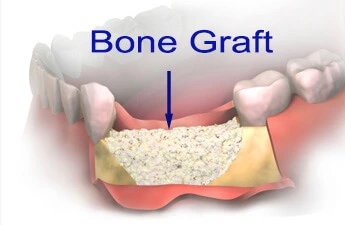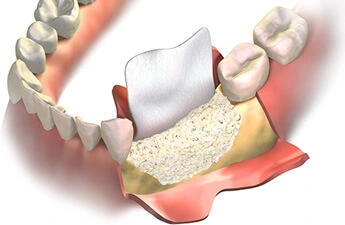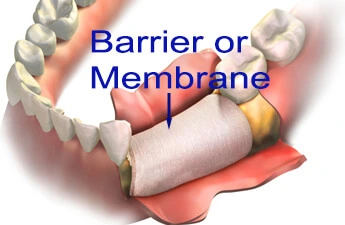
Periodontal Bone Grafting
What Is Dental Bone Grafting and Why Do I Need It?
Dental bone grafting is a surgical procedure used to replace or restore lost bone around the teeth. The reason for bone grafting is to increase the support and strength of the teeth so they are not lost. Periodontal bone loss results from gum disease. As more bone is lost from untreated periodontal disease, the teeth can become loose and may need to be removed. Bone grafting can reverse bone loss and cause your body to regenerate or make new bone that supports the teeth.
The procedure is typically performed under local anesthesia in Dr. Wiland's office. A grafting material that is purchased is placed in the area where the bone has been lost. It may be covered by a special membrane to help guide the area to heal correctly. This process is called guided tissue regeneration. The bone graft maintains space until your body makes your living bone that fills the space. It will take time for the new bone to form. During this time, you must follow instructions for proper care. This may include eating a soft diet, avoiding smoking and alcohol consumption, taking antibiotics, and keeping your mouth clean.
Bone grafting around natural teeth can also help regrow the jawbone and increase support for your teeth. If you need dental bone grafting, it's important to speak with Dr. Wiland as soon as possible. With proper care and attention, this procedure can help improve the structure and health of your mouth for many years to come.
What Is Bone Graft Made of, and Where Does It Come From?
Bone grafts are made naturally or come from animal or synthetic materials. There are several choices of bone grafting materials.
Autogenous Bone Grafts
Natural bone grafts are taken from a donor site elsewhere on the patient's body and placed at the site of the bone defect. Natural grafts provide the best long-term stability and strength. Sometimes your own bone is collected from the area of the surgery. Some situations require obtaining your own bone from a different site within your mouth.
Xenografts
These are bone grafts from a different animal than a human. Usually, bovine or cow bone is used. The bone is processed in a way that makes it very safe. The living cells have been removed, so there is no chance of rejection. The advantage of this material is that it will not resorb or dissolve away quickly, which allows more time for your body to make the bone that is really needed.
Allografts
These bone grafts come from an animal other than a human. The bone is prepared to remove cells and other substances that could cause a problem. Dr. Wiland only uses bone from companies that are members of The American Association of Tissue Banks (AATB). AATB is a professional, non-profit, and scientific organization that promotes the safety and quality of human tissue. More about where the bone comes from can be found at Community Tissue Services.
Alloplastic grafts
These are bone grafts made from a synthetic bone material or artificial substitute. Examples of this type of bone grafting material include hydroxyapatite and tricalcium phosphate.
Different bone grafting materials can also be combined to give improved outcomes. Usually, a membrane will be used as well as a biologic such as Emdogain to help your body make new bone to support your teeth. Platelet Rich Fibrin is also sometimes used to have the best results. These treatments help guide the natural healing process and can give the greatest benefit.
What Is Guided Tissue Regeneration?
Guided tissue regeneration is a technique that uses a barrier to control or guide the way an area heals so new bone forms or regenerates. A membrane or barrier is placed under the gum and covers a bone graft and your bone. The gum tissue grows fast and is blocked from growing down into the bone defect by the barrier. The slower growing bone is allowed to fill the area that has bone loss and needs new bone. If the barrier does not resorb, then it is removed after about 8 weeks. This is a simple procedure that takes about 10-15 minutes and is painless. Complete healing and maturation of the bone may take about 6 months. Guided tissue regeneration can be used around implants and natural teeth. It can also be used in areas where teeth are not present and there is a need to have more bone height and width.



Is Gum Bone Grafting Painful?
Bone grafting does not increase the pain after surgery. Medication is used on the day the surgery is completed. The day after the surgery, most people take Tylenol or ibuprofen for any discomfort.
Contact Indyperio Today to Schedule an Appointment
Our goal is to comfortably preserve your natural dentition and dental implants in health, aesthetics, and function. We look forward to the privilege of serving you in the most professional manner possible.
 Schedule an Appointment
Schedule an Appointment
